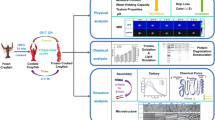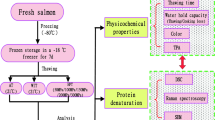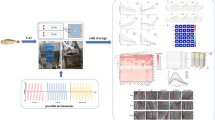Abstract
The preservation of harvested fish is important in fisheries production. To investigate the effect of acute cold stress on preserving the freshness of large yellow croaker, which has the highest expression of ISP2 mRNA in its muscle, under ice-temperature storage and frozen storage, acute cold stress durations were investigated first. According to the results of the above test, large yellow croakers were subjected to acute cold stress for 40 min, followed by ice-temperature storage or frozen storage. The K values, sensory attributes, and protein compositions of large yellow croaker under ice-temperature storage or frozen storage for different durations were investigated in this study. The results showed that acute cold stress treatment affects the ice-temperature storage and frozen storage of large yellow croaker. In the muscle of large yellow croaker under ice-temperature storage for 1, 2, 3, and 5 d, the K values of the acute cold stress groups were significantly lower than those of the control groups (not subjected to acute cold stress). In the muscle of large yellow croaker under frozen storage, the sensory evaluation scores of the acute cold stress groups were greater than those of the control group until a storage time of 60 d. With an extension of frozen storage, there were changes in the contents of myofibrillar protein, myogen, muscle matrix protein, and alkali-soluble protein. The myofibrillar protein, myogen, and muscle matrix protein contents of the acute cold stress groups were greater than those of the control groups after short-term frozen storage, while the alkali-soluble protein contents of the acute cold stress groups were lower than those of the control groups, except for durations of 1, 3, 15, 19, and 22 d. In addition, the K values of the acute cold stress groups were significantly lower than those of the control groups after frozen storage for 1, 2, 3, 5, 9, 15, 19, and 22 d. The results indicate that treatment with acute cold stress for 40 min affects the preservation of large yellow croaker.











Similar content being viewed by others
Data Availability
The datasets generated during or analyzed during the current study are available from the corresponding author on reasonable request.
References
Arav, A., Rubinsky, B., Fletcher, G., & Seren, E. (1993). Cryogenic protection of oocytes with antifreeze proteins. Molecular Reproduction and Development, 36(4), 488–493. https://doi.org/10.1002/mrd.1080360413
Arulkumar, A., Paramasivam, S., & Miranda, J. M. (2018). Combined effect of icing medium and red alga Gracilaria verrucosa on shelf life extension of Indian mackerel (Rastrelliger kanagurta). Food and Bioprocess Technology, 11, 1911–1922. https://doi.org/10.1007/s11947-018-2154-x
Baskaran, A., Kaari, M., Venugopal, G., Manikkam, R., Joseph, J., & Bhaskar, P. V. (2021). Anti freeze proteins (Afp): Properties, sources and applications – A review. International Journal of Biological Macromolecules, 189, 292–305. https://doi.org/10.1016/j.ijbiomac.2021.08.105
Bazargani-Gilani, B., & Pajohi-Alamoti, M. (2020). The effects of incorporated resveratrol in edible coating based on sodium alginate on the refrigerated trout (Oncorhynchus mykiss) fillets’ sensorial and physicochemical features. Food and Bioprocess Technology, 29(2), 207–216. https://doi.org/10.1007/s10068-019-00661-1
Bou, R., Guerrero, L., López, M., Claret, A., López-Mas, L., & Castellari, M. (2023). Effect of vacuum impregnation and high hydrostatic pressure treatments on shelf life, physicochemical, and sensory properties of seabream fillets. Food and Bioprocess Technology, 16, 1089–1100. https://doi.org/10.1007/s11947-022-02980-4
Cai, L. Y., Nian, L. Y., Cao, A. L., Zhang, Y. H., & Li, X. X. (2020). Effect of carboxymethyl chitosan magnetic nanoparticles plus herring antifreeze protein on conformation and oxidation of myofibrillar protein from red sea bream (Pagrosomus major) after freeze-thaw treatment. Food and Bioprocess Technology, 13, 355–366. https://doi.org/10.1007/s11947-019-02384-x
Cao, Q. J., Du, H. Y., Huang, Y., Hu, Y., You, J., Liu, R., & Xiong, S. B. (2019). The inhibitory effect of chlorogenic acid on lipid oxidation of grass carp (Ctenopharyngodon idellus) during chilled storage. Food and Bioprocess Technology, 12, 2050–2061. https://doi.org/10.1007/s11947-019-02365-0
Chang, L. (2016). Research and development of preservative based on gracilaria lemaneiformis oligosaccharides on fish. Jimei University.
Chao, H., Davies, P. L., & Carpenter, J. F. (1996). Effects of antifreeze proteins on red blood cell survival during cryopreservation. Journal of Experimental Biology, 199(9), 2071–2076. https://doi.org/10.1242/jeb.199.9.2071
Chen, F. L., Bao, H., Qu, M., & Li, L. L. (2016). Advances in detection of thermal hysteresis activity of ice structuring proteins. Farm Products Processing, 2, 56–58. https://doi.org/10.16693/j.cnki.1671-9646(X).2016.02.045
Cheng, J. H., Sun, D. W., & Wei, Q. Y. (2017). Enhancing visible and near-infrared hyperspectral imaging prediction of TVB-N Level for fish fillet freshness evaluation by filtering optimal variables. Food Analytical Methods, 10, 1888–1898. https://doi.org/10.1007/s12161-016-0742-9
DeVries, A. L., & Wohlschlag, D. E. (1969). Freezing resistance in some Antarctic fishes. Science, 163(3871), 1073–1075. https://doi.org/10.1126/science.163.3871.1073
Fan, K. K., Liu, A. G., Chen, D., Zeng, G. J., Wang, H., & Feng, X. Y. (2012). Study on ice structuring proteins and its application. Food Research and Development, 33(9), 221–225.
Fraser, D. I., Dingle, J. A., Hines, J. A., Nowlan, S. C., & Dyer, W. J. (1967). Nucleotide degradation, monitored by thin-layer chromatography, and associated postmortem changes in relaxed cod muscle. Journal of the Fisheries Board of Canada, 24(8), 1837–1841. https://doi.org/10.1139/f67-152
Ghaly, A. E., Dave, D., Budge, S., & Brooks, M. S. (2010). Fish spoilage mechanisms and preservation techniques: Review. American Journal of Applied Sciences, 7(7), 859–877.
Guo, R. Y., Ling, J. G., Ye, Y. F., Cui, Y., & Ou, C. R. (2016). Effect of superchilling in slurry ice on the preservation of farmed large yellow croaker (Pseudosciae)a crocea). Science and Technology of Food Industry, 37(8), 307–312. https://doi.org/10.13386/j.issn1002-0306.2016.08.056
Ideta, A., Aoyagi, Y., Tsuchiya, K., Nakamura, Y., Hayama, K., Shirasawa, A., & Tsuda, S. (2015). Prolonging hypothermic storage (4 ℃) of bovine embryos with fish antifreeze protein. Journal of Reproduction and Development, 61(1), 1–6. https://doi.org/10.1262/jrd.2014-073
Ji, R. Q., Liu, A. G., Chen, L., Wu, Z. J., Hu, Z. B., & Liu, B. (2015). Relationship between structure and antifreeze activity in fish antifreeze proteins. Food Science, 36(5), 274–282. https://doi.org/10.7506/spkx1002-6630-201505049
Jiang, W. J. (2013). Studies of effects of bamboo extract on quality improvement and preservation of cultured large yellow croaker. Zhejiang University.
Jin, Z. Y., & Liu, B. L. (2014). Antifreeze proteins and its application research. Food Research and Development, 35(20), 142–146. https://doi.org/10.3969/j.issn.1005-6521.2014.20.036
Kan, Y. L. (2018). Influence of regulating superchilling on the quality and physicochemical properties of yellow croaker muscle during storage. Northeast Agricultural University.
Kim, H. J., Lee, J. H., Hur, Y. B., Lee, C. W., Park, S. H., & Koo, B. W. (2017). Marine antifreeze proteins: Structure, function, and application to cryopreservation as a potential cryoprotectant. Marine Drugs, 15(2), 1–27. https://doi.org/10.3390/md15020027
Lan, W. Q., Du, J. T., Liu, L., Pu, T. T., Zhou, Y. X., & Xie, J. (2022). SA – SI Treatment: A potential method to maintain the quality and protein properties on mackerel (Pneumatophorus japonicus) during chilling storage. Food and Bioprocess Technology, 15, 1603–1614. https://doi.org/10.1007/s11947-022-02827-y
Liu, H. Y., Wang, H. Q., Gao, H., Liu, K., & Zhu, M. (1998). A simple method for determination of K value as an index of fish freshness. Journal of Qingdao University (natural Science), 11(2), 50–53.
Liu, M. H. (2004). Studies on large yellow croaker in partial freezing. Fujian Agriculture and Forestry University.
Liu, Y. G., Lou, Y. J., Tu, B. X., & Li, L. C. (2013). Physico-chemical properties changes during the frozen storage of farmed Pseudosciaena crocea muscle after freezing by different methods. Science and Technology of Food Industry, 34(10), 331–333, 337. https://doi.org/10.13386/j.issn1002-0306.2013.10.072
Lu, T., Qiu, J. S., Xu, L. P., Zhou, J., & He, J. L. (2021). Effects of different preservation techniques on the quality of Pseudosciaena crocea. Journal of Food Safety & Quality, 12(23), 9199–9203. https://doi.org/10.19812/j.cnki.jfsq11-5956/ts.2021.23.030
Lv, J. W. (2013). Combined effect of lysozyme and Nisin on quality of cultured large yellow croaker (Pseudosciaena Crocea) during refrigerated storage. Zhejiang Gongshang University.
Massa, A. E., Palacios, D. L., Paredi, M. E., & Crupkin, M. (2005). Postmortem changes in quality indices of ice-stored flounder (Paralichthys patagonicus). Journal of Food Biochemistry, 29(5), 570–590. https://doi.org/10.1111/j.1745-4514.2005.00050.x
Miranda, J. M., Trigo, M., Barros-Velázquez, J., & Aubourg, S. P. (2018). Quality enhancement of chilled lean fish by previous active dipping in Bifurcaria bifurcata alga extract. Food and Bioprocess Technology, 11, 1662–1673. https://doi.org/10.1007/s11947-018-2131-4
Mol, S., Akan, T., Kartal, S., Coşansu, S., Tosun, ŞY., Alakavuk, D. Ü., Ulusoy, Ş, Doğruyol, H., & Bostan, K. (2023). Effects of air and helium cold plasma on sensory acceptability and quality of fresh sea bass (Dicentrarchus labrax). Food and Bioprocess Technology, 16, 537–548. https://doi.org/10.1007/s11947-022-02950-w
Ni, Q. F. (2013). The effects of tea polyphenol combined with chitosan coating on muscle protein of refrigerated large yellow croaker (Pseudosciaena Crocea). Zhejiang: Zhejiang Gongshang University. oligosaccharides on fish. Fujian: Jimei University.
Ni, Q. F., Li, T. T., Fu, Y. Y., Pan, W. C., Xie, J., & Gu, J. R. (2014). Biochemical properties and degradation rule of muscle protein from large yellow croaker (Pseudosciaena crocea) during chilled storage. Journal of Chinese Institute of Food Science and Technology, 14(6), 41–47. https://doi.org/10.16429/j.1009-7848.2014.06.020
Qian, B. Y., & Xue, L. Y. (2016). Liver transcriptome sequencing and de novo annotation of the large yellow croaker (Larimichthy crocea) under heat and cold stress. Marine Genomics, 25, 95–102. https://doi.org/10.1016/j.margen.2015.12.001
Rubinksy, B., Arav, A., & Fletcher, G. L. (1991). Hypothermic protection-a fundamental property of “antifreeze” proteins. Biochemical and Biophysical Research Communications, 180, 566–571. https://doi.org/10.1016/S0006-291X(05)81102-7
Schmittgen, T. D., & Livak, K. J. (2008). Analyzing real-time PCR data by the comparative CT method. Nature Protocols, 3(6), 1101–1108. https://doi.org/10.1038/nprot.2008.73
Tang, J. M., Liao, Y. Y., Tang, H. Q., & Ou, C. R. (2019). Effect of different freezing rates on the quality of Pseudosciaena crocea during frozen storage. Journal of Ningbo University (natural Science & Engineering Edition), 32(6), 35–42.
Tao, W. B., Wu, Y. Y., & Li, L. H. (2018). Status of processing and preservation technology of breeding Pseudosciaena crocea. Science and Technology of Food Industry, 39(11), 339–343. https://doi.org/10.13386/j.issn1002-0306.2018.11.058
Villoutreix, B. O., Fernández, J. A., Teleman, O., & Griffin, J. H. (1995). Comparative modeling of the three CP modules of the beta-chain of C4BP and evaluation of potential sites of interaction with protein S. Protein Engineering, 8(12), 1253–1258. https://doi.org/10.1093/protein/8.12.1253
Wang, Z. Z. (2009). Research on preservation technology of Pseudosciaena crocea with controlled freezing-point and modified atmosphere packaging. Ocean University of China.
Wu, G., Lv, Y., Chu, Y. M., Zhang, X. R., Ding, Z. Y., & Xie, J. (2022). Evaluation of preservation (−23 to 4 °C) for cuttlefish through functional ice glazing during storage and cold chain logistics. Food and Bioprocess Technology, 16, 68–81. https://doi.org/10.1007/s11947-022-02921-1
Wu, S. L., Kang, H. B., & Li, D. J. (2019). Research status and application progress of fresh-keeping technology of aquatic products. Journal of Anhui Agricultural Sciences, 47(22), 4–6, 33.
Xie, W. L., Huang, Y., Xiang, Y. Z., Xiong, S. B., Manyande, A., & Du, H. Y. (2020). Insights into the binding mechanism of polyphenols and fish myofibrillar proteins explored using multi-spectroscopic methods. Food and Bioprocess Technology, 13, 797–806. https://doi.org/10.1007/s11947-020-02439-4
Yang, M. (2016). A preliminary study on the functionsof a multimer type III antifreeze protein in low temperature tolerance. Shanghai Ocean University.
Yang, W., & Wang, C. M. (2020). Development of Larimichthys Crocea breeding industry in China. Ocean Development and Management, 37(05), 72–75.
Yu, Y. W., Zhu, X. R., Qiu, H. H., & Zhang, J. (2017). Biochemical properties of muscle protein from Coregonus peled during frozen storage. Food Science and Technology, 42(11), 157–162. https://doi.org/10.13684/j.cnki.spkj.2017.11.029
Yuan, X. M. (2017). Effect of partial freezing ice on keeping freshness of Nile Tilapia (Oreochromis niloticus) fillets. Shanghai Ocean University.
Zhang, Y. X., Xie, C. M., Zhou, F., Zhang, C. X., & Wang, X. C. (2019). Research progress on preservation technology of pseudosciaena crocea. Science and Technology of Food Industry, 40(13), 299–303, 309. https://doi.org/10.13386/j.issn1002-0306.2019.13.050
Zhao, P. C., Zhao, N. N., Lv, F., & Ding, Y. T. (2015). A Review of novel detection technologies for the freshness of marine aquatic products. Journal of Food Science and Biotechnology, 34(9), 897–905.
Zhu, F. L., Zhang, D. R., He, Y., Liu, F., & Sun, D. W. (2013). Application of visible and near infrared hyperspectral imaging to differentiate between fresh and frozen–thawed fish fillets. Food and Bioprocess Technology, 6, 2931–2937. https://doi.org/10.1007/s11947-012-0825-6
Acknowledgements
We thank the funding support provided by the Zhejiang Provincial Natural Science Foundation of China (Grant No. LGN18C190007), Taizhou science and technology project (Grant No.1901ny09), and the Science & Technology Project of Taizhou (Grants No. 21hb04 and 21nya17). And thank International Science Editing for language editing this manuscript too.
Funding
Tish work was supported by Zhejiang Provincial Natural Science Foundation of China (Grant No. LGN18C190007), Taizhou science and technology project (Grant No.1901ny09), and the Science & Technology Project of Taizhou (Grants No. 21hb04 and 21nya17).
Author information
Authors and Affiliations
Contributions
All authors listed in this study meet the authorship requirements. Weiping Xiang, Hanqin Chen, Yushan Jin, Yinuo Chen performed the experiments, analyzed data, and wrote this manuscript. Baoying Qian and Xin Qi conceived and designed experiments, approved the final draft, and contributed in acquisition of funding. All authors read and approved this final manuscript.
Corresponding authors
Ethics declarations
Ethics Approval
All procedures and investigations were reviewed and approved by the Center for Laboratory Animals of Taizhou University. The protocols used the “Zhejiang Laboratory Animal Management” guidelines established by the Zhejiang Provincial Department of Science and Technology on the Use and Care of Animals.
Consent to Participate
Not applicable.
Consent for Publication
Not applicable.
Conflict of Interest
All authors declare no competing interests.
Additional information
Publisher's Note
Springer Nature remains neutral with regard to jurisdictional claims in published maps and institutional affiliations.
Rights and permissions
Springer Nature or its licensor (e.g. a society or other partner) holds exclusive rights to this article under a publishing agreement with the author(s) or other rightsholder(s); author self-archiving of the accepted manuscript version of this article is solely governed by the terms of such publishing agreement and applicable law.
About this article
Cite this article
Xiang, W., Chen, H., Jin, Y. et al. Effect of Acute Cold Stress on Preserving the Freshness of Large Yellow Croaker Under Ice-Temperature and Frozen Storage. Food Bioprocess Technol (2024). https://doi.org/10.1007/s11947-024-03337-9
Received:
Accepted:
Published:
DOI: https://doi.org/10.1007/s11947-024-03337-9




